Composite restorations – but not as you know them – Claire Burgess
News Promotional FeaturesPosted by: Dental Design 3rd September 2019
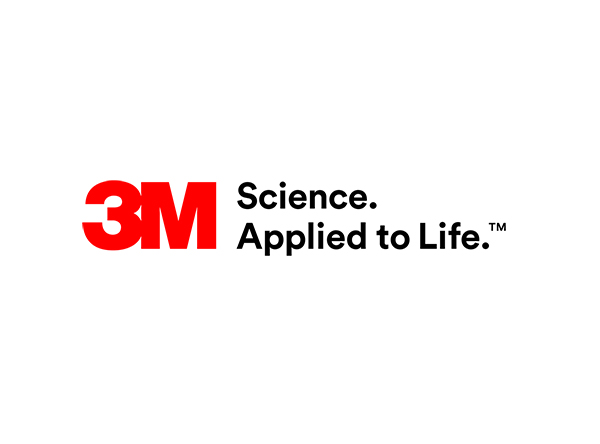
 Composite is a great material to use in restorative or cosmetic dentistry for a wide array of indications. However, traditional layered composite restorations are an area that most dentists find challenging to achieve good long-term results as they often fail due to chipping or staining. Other common challenges in this field include lack of shine retention, difficult handling with somewhat complex and multi-staged application protocols, negative impact on the surrounding soft tissue, and weakening of the natural teeth, especially when they are chipped or endodontically treated.
Composite is a great material to use in restorative or cosmetic dentistry for a wide array of indications. However, traditional layered composite restorations are an area that most dentists find challenging to achieve good long-term results as they often fail due to chipping or staining. Other common challenges in this field include lack of shine retention, difficult handling with somewhat complex and multi-staged application protocols, negative impact on the surrounding soft tissue, and weakening of the natural teeth, especially when they are chipped or endodontically treated.
Composite restorations using the Bioclear Method provide a solution in that they offer great longevity, shine retention and strength. They also provide an ideal way to address black triangles and diastemas, which is an issue in dentistry that, until now, dentists have not had a consistent, non-invasive and successful way to treat. Using the Bioclear Method allows clinicians to expand the treatment options available to their patients, allowing them to use composite – which is often a much more conservative alternative to other restorative techniques like veneers – to address both cosmetic and functional concerns.
I really appreciate several aspects of being able to provide my patients with composite restorations utilising the Bioclear Method. These include:
- Great predictability for both short- and long-term outcomes.
- Producing restorations with great shine retention, lack of staining and high strength.
- Providing aesthetically pleasing restorations that are less invasive and more respectful to the teeth than other restorative options.
- Being able to address genuine patient cosmetic concerns in a less costly manner than indirect alternatives.
- To repair teeth in a respectful and predictable manner.
- Being able to address patient cosmetic concerns in a minimally invasive/conservative manner.
The Bioclear Method enables the clinician to overcome many of the conventional challenges often faced with composite restorations. It offers a simple workflow following instruction from a course at the Learning Centres and therefore encourages more reproducible results than traditional layering techniques. It also promotes health of the surrounding soft tissues, especially with regards to black triangle and diastema closure.
My initial introduction to Bioclear came with the discovery of the anatomical anterior Bioclear Matrices that were used on a patient during a training course I attended in 2011. The matrices became available in the UK in October 2012 and I have used Bioclear matrices in practice ever since. I was introduced to the Bioclear Method at the Learning Centre Headquarters with David Clark in 2014 and from 2015 onwards, I have only performed Bioclear Method composite restorations. Having lectured on composite restorations on the PG Certificate and Advanced Contemporary and Aesthetic Dentistry Courses at the Dominic Hassall Training Institute since 2012, I became the UK Certified Bioclear Method Instructor in 2015, and present courses at the International Bioclear Learning Centre in Solihull.
The UK Bioclear Learning Centre teaches level 1, 2, 3.0, and 4 courses. Delegates have the option of attending independent 2-day anterior or posterior courses, or Bioclear course days within both the Certificate and Diploma level Dominic Hassall Residential and Online Restorative Courses. Further advanced courses are available at the Bioclear Headquarters Learning Centre in Tacoma (USA). Dentistswho complete the training can submit cases to the Master Track Accreditation to become a Master Level Bioclear Practitioner. This can then allow them to become involved in certified instruction if they wish.
The courses cover all theory aspects related to anterior and posterior Bioclear Method restorations, but they are also very practically based. This hands-on element is essential for giving dentists the experience and skills to allow for predictable, longer lasting, stronger and aesthetically superior restorations. Delegates perform modern preparations and injections moulding to create restorations with ideal margins, rounded emergence profiles and mirror-smooth finishes. The courses use Filtek™ Supreme Flowable Restorative and body Filtek™ Supreme XTE Restorative composite for anterior restorations, as well as Filtek™ Flowable Bulk Fill Restorative composite and Filtek™ One Bulk Fill Restorative composite for posterior restorations from 3M. These materials are very suitable to use with the Bioclear Method as they can be heated for injection moulding using the Bioclear HeatSync Heater, and their long-term polish retention is ideal.
By attending courses at a Certified Bioclear Learning Centre, delegates receive high level of instruction as it is run by Certified Instructors. On completion of advanced courses, dentists can apply to be Certified Practitioners through the Bioclear Headquarters in Tacoma. All delegates whoattend courses at the Dominic Hassall Training Institute or Bioclear Learning Centre receive support from the instructors and are updated on information and courses over time.
Images
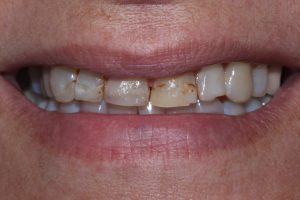
Case 1 – Pre smile
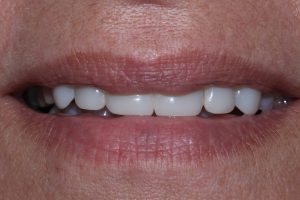
Case 1 – Post smile
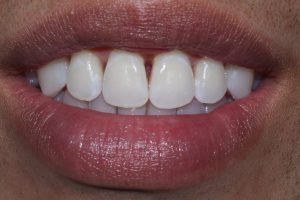
Case 2 – Pre black triangle closure
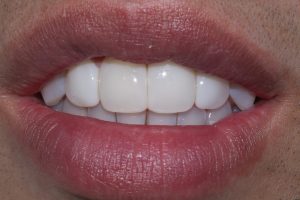
Case 2 – 12 months post black triangle closure
For further details about the BioClear concept and products, visit www.bioclearmatrix.com
https://dominic-hassall-training.co.uk/bioclear-courses/

For more information about products from 3M Oral Care, call 0800 626 578 or visit www.3M.co.uk/Dental
Author Biography
Claire Burgess.
General & Aesthetic Dentist
Certified UK Bioclear Instructor
BDS (Birmingham)
MFGDP RCS (Eng)
MSc Restorative & Cosmetic Dentistry (UCLan)
Claire graduated from Birmingham University in 1999. Since then she has lived and worked in the area as an associate in general practice. She completed two, year-long courses on restorative and aesthetic dentistry in 2003/2004, and was awarded the Membership of the Faculty of General Dental Practitioners (MFGDP) by the Royal College of Surgeons in 2007. This progression led Claire to embark on a three-year MSc in Advanced Restorative and Cosmetic Dentistry at the University of Central Lancashire. It was during this time she was invited to join the team at Smile Concepts. She was successfully awarded her MSc in December 2012.
Claire was a finalist in the Restorative category of the National Smile Awards in 2010 and 2011 – the only dentist in the West Midlands to have been a finalist two years running.
She has lectured on Composite Restorations on the PG Certificate Restorative and Aesthetic Dentistry Courses at the Dominic Hassall Training Institute since 2012. In 2015, Claire became the UK Certified Bioclear Method Instructor, and undertakes Level 1-4 courses at the International Bioclear Learning Centre in Solihull. She is the only certified Bioclear Method instructor in the UK. Clinically, since 2014 she has only performed Bioclear Method type composite restorations. She lectures in Bioclear Method Anterior and Posterior Composite Restorations on the PG Certificate and Advanced Contemporary Restorative and Aesthetic Dentistry Courses at the Dominic Hassall Training Institute. This is the only restorative course to contain solely Bioclear Method Restoration tuition.
She is a fellow member of the British Academy of Aesthetic, Restorative and Implant Dentistry (BARRID), and has contributed to articles published in the International Journal of Advanced Clinical Dentistry and Private Dentistry. She has lectured internationally in the Bioclear Method.
No Comments
No comments yet.
Sorry, the comment form is closed at this time.



